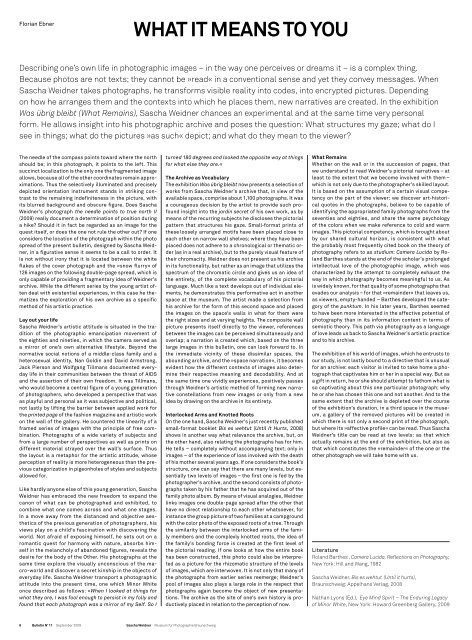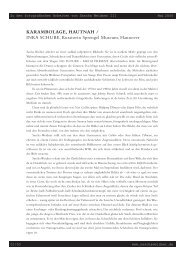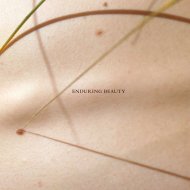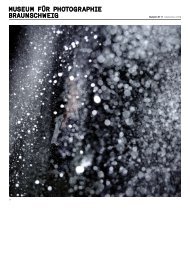MuseuM für PhotograPhie Braunschweig - Sascha Weidner
MuseuM für PhotograPhie Braunschweig - Sascha Weidner
MuseuM für PhotograPhie Braunschweig - Sascha Weidner
Erfolgreiche ePaper selbst erstellen
Machen Sie aus Ihren PDF Publikationen ein blätterbares Flipbook mit unserer einzigartigen Google optimierten e-Paper Software.
Florian Ebner<br />
WHAT IT MEANS TO YOU<br />
Describing one’s own life in photographic images – in the way one perceives or dreams it – is a complex thing.<br />
Because photos are not texts; they cannot be »read« in a conventional sense and yet they convey messages. When<br />
<strong>Sascha</strong> <strong>Weidner</strong> takes photographs, he transforms visible reality into codes, into encrypted pictures. Depending<br />
on how he arranges them and the contexts into which he places them, new narratives are created. In the exhibition<br />
Was übrig bleibt (What Remains), <strong>Sascha</strong> <strong>Weidner</strong> chances an experimental and at the same time very personal<br />
form. He allows insight into his photographic archive and poses the question: What structures my gaze; what do I<br />
see in things; what do the pictures »as such« depict; and what do they mean to the viewer?<br />
The needle of the compass points toward where the north<br />
should be; in this photograph, it points to the left. This<br />
succinct localization is the only one the fragmented image<br />
allows, because all of the other coordinates remain approximations.<br />
Thus the selectively illuminated and precisely<br />
depicted orientation instrument stands in striking contrast<br />
to the remaining indefiniteness in the picture, with<br />
its blurred background and obscure figure. Does <strong>Sascha</strong><br />
<strong>Weidner</strong>’s photograph the needle points to true north II<br />
(2009) really document a determination of position during<br />
a hike? Should it in fact be regarded as an image for the<br />
quest itself, or does the one not rule the other out? If one<br />
considers the location of the photograph within the photo<br />
spread of the present bulletin, designed by <strong>Sascha</strong> <strong>Weidner</strong>,<br />
in a figurative sense it seems to be a call to order. It<br />
is not without irony that it is located between the white<br />
flakes of the cover photograph and the »snow flurry« of<br />
126 images on the following double-page spread, which is<br />
only capable of providing a fragmentary idea of <strong>Weidner</strong>’s<br />
archive. While the different series by the young artist often<br />
deal with existential experiences, in this case he thematizes<br />
the exploration of his own archive as a specific<br />
method of his artistic practice.<br />
Lay out your life<br />
<strong>Sascha</strong> <strong>Weidner</strong>’s artistic attitude is situated in the tradition<br />
of the photographic emancipation movement of<br />
the eighties and nineties, in which the camera served as<br />
a mirror of one’s own alternative lifestyle. Beyond the<br />
normative social notions of a middle-class family and a<br />
heterosexual identity, Nan Goldin and David Armstrong,<br />
Jack Pierson and Wolfgang Tillmans documented everyday<br />
life in their communities between the threat of AIDS<br />
and the assertion of their own freedom. It was Tillmans,<br />
who would become a central figure of a young generation<br />
of photographers, who developed a perspective that was<br />
as playful and personal as it was subjective and political,<br />
not lastly by lifting the barrier between applied work for<br />
the printed page of the fashion magazine and artistic work<br />
on the wall of the gallery. He countered the linearity of a<br />
framed series of images with the principle of free combination.<br />
Photographs of a wide variety of subjects and<br />
from a large number of perspectives as well as prints on<br />
different material strayed over the wall’s surface. Thus<br />
the layout is a metaphor for the artistic attitude, whose<br />
perception of reality is more heterogeneous than the previous<br />
categorization in pigeonholes of styles and subjects<br />
allowed for.<br />
Like hardly anyone else of this young generation, <strong>Sascha</strong><br />
<strong>Weidner</strong> has embraced the new freedom to expand the<br />
canon of what can be photographed and exhibited, to<br />
combine what one comes across and what one stages.<br />
In a move away from the distanced and objective aesthetics<br />
of the previous generation of photographers, his<br />
views play on a child’s fascination with discovering the<br />
world. Not afraid of exposing himself, he sets out on a<br />
romantic quest for harmony with nature, absorbs himself<br />
in the melancholy of abandoned figures, reveals the<br />
desire for the body of the Other. His photographs at the<br />
same time explore the visually unconscious of the macro-world<br />
and discover a secret kinship in the objects of<br />
everyday life. <strong>Sascha</strong> <strong>Weidner</strong> transport a photographic<br />
attitude into the present time, one which Minor White<br />
once described as follows: »When I looked at things for<br />
what they are, I was fool enough to persist in my folly and<br />
found that each photograph was a mirror of my Self. So I<br />
turned 180 degrees and looked the opposite way at things<br />
for what else they are.«<br />
The Archive as Vocabulary<br />
The exhibition Was übrig bleibt now presents a selection of<br />
works from <strong>Sascha</strong> <strong>Weidner</strong>’s archive that, in view of the<br />
available space, comprise about 1,100 photographs. It was<br />
a courageous decision by the artist to provide such profound<br />
insight into the jardin secret of his own work, as by<br />
means of the recurring subjects he discloses the pictorial<br />
pattern that structures his gaze. Small-format prints of<br />
these loosely arranged motifs have been placed close to<br />
each other on narrow wall shelves; where they have been<br />
placed does not adhere to a chronological or thematic order<br />
(as in a real archive), but to the purely visual feature of<br />
their chromacity. <strong>Weidner</strong> does not present us his archive<br />
in its functionality, but rather as an image that utilizes the<br />
spectrum of the chromatic circle and gives us an idea of<br />
the entirety, of the complete vocabulary of his pictorial<br />
language. Much like a text develops out of individual elements,<br />
he demonstrates this performative act in another<br />
space at the museum. The artist made a selection from<br />
his archive for the form of this second space and placed<br />
the images on the space’s walls in what for them were<br />
the right sizes and at varying heights. The composite wall<br />
picture presents itself directly to the viewer, references<br />
between the images can be perceived simultaneously and<br />
overlap; a narration is created which, based on the three<br />
large images in this bulletin, one can look forward to. In<br />
the immediate vicinity of these dissimilar spaces, the<br />
abounding archive, and the »space narration«, it becomes<br />
evident how the different contexts of images also determine<br />
their respective meaning and decodability. And at<br />
the same time one vividly experiences, positively passes<br />
through <strong>Weidner</strong>’s artistic method of forming new narrative<br />
constellations from new images or only from a new<br />
idea by drawing on the archive in its entirety.<br />
Interlocked Arms and Knotted Roots<br />
On the one hand, <strong>Sascha</strong> <strong>Weidner</strong>’s just recently published<br />
small-format booklet Bis es wehtut (Until It Hurts, 2008)<br />
shows in another way what relevance the archive, but, on<br />
the other hand, also relating the photographs has for him.<br />
He tells – completely without accompanying text; only in<br />
images – of the experience of loss involved with the death<br />
of his mother several years ago. If one considers the book’s<br />
structure, one can say that there are many levels, but essentially<br />
two levels of images – the first one is fed by the<br />
photographer’s archive, and the second consists of photographs<br />
taken by his father that he has acquired out of the<br />
family photo album. By means of visual analogies, <strong>Weidner</strong><br />
links images one double-page spread after the other that<br />
have no direct relationship to each other whatsoever, for<br />
instance the group picture of two families at a campground<br />
with the color photo of the exposed roots of a tree. Through<br />
the similarity between the interlocked arms of the family<br />
members and the complexly knotted roots, the idea of<br />
the family’s bonding force is created at the first level of<br />
the pictorial reading. If one looks at how the entire book<br />
has been constructed, this photo could also be interpreted<br />
as a picture for the rhizomatic structure of the levels<br />
of images, which are interwoven. It is not only that many of<br />
the photographs from earlier series reemerge; <strong>Weidner</strong>’s<br />
pool of images also plays a large role in the respect that<br />
photographs again become the object of new presentations.<br />
The archive as the site of one’s own history is productively<br />
placed in relation to the perception of now.<br />
What Remains<br />
Whether on the wall or in the succession of pages, that<br />
we understand to read <strong>Weidner</strong>’s pictorial narratives – at<br />
least to the extent that we become involved with them –<br />
which is not only due to the photographer’s skilled layout.<br />
It is based on the assumption of a certain visual competency<br />
on the part of the viewer: we discover art-historical<br />
quotes in the photographs, believe to be capable of<br />
identifying the appropriated family photographs from the<br />
seventies and eighties, and share the same psychology<br />
of the colors when we make reference to cold and warm<br />
images. This pictorial competency, which is brought about<br />
by our shared cultural horizon, is consistent with what<br />
the probably most frequently cited book on the theory of<br />
photography refers to as studium: Camera Lucida by Roland<br />
Barthes stands at the end of the scholar’s prolonged<br />
intellectual love of the photographic image, which was<br />
characterized by the attempt to completely exhaust the<br />
way in which photography becomes meaningful to us. As<br />
is widely known, for that quality of some photographs that<br />
evades our analysis – for that »remainder« that leaves us,<br />
as viewers, empty-handed – Barthes developed the category<br />
of the punktum. In his later years, Barthes seemed<br />
to have been more interested in the affective potential of<br />
photography than in its information content in terms of<br />
semiotic theory. This path via photography as a language<br />
of love leads us back to <strong>Sascha</strong> <strong>Weidner</strong>’s artistic practice<br />
and to his archive.<br />
The exhibition of his world of images, which he entrusts to<br />
our study, is not lastly bound to a directive that is unusual<br />
for an archive: each visitor is invited to take home a photograph<br />
that captivates him or her in a special way. But as<br />
a gift in return, he or she should attempt to fathom what is<br />
so captivating about this one particular photograph; why<br />
he or she has chosen this one and not another. And to the<br />
same extent that the archive is depleted over the course<br />
of the exhibition’s duration, in a third space in the museum,<br />
a gallery of the removed pictures will be created in<br />
which there is not only a second print of the photograph,<br />
but where its »affective profile« can be read. Thus <strong>Sascha</strong><br />
<strong>Weidner</strong>’s title can be read at two levels: as that which<br />
actually remains at the end of the exhibition, but also as<br />
that which constitutes the »remainder« of the one or the<br />
other photograph we will take home with us.<br />
Literature<br />
Roland Barthes , Camera Lucida, Reflections on Photography,<br />
New York: Hill and Wang, 1982<br />
<strong>Sascha</strong> <strong>Weidner</strong>, Bis es wehtut (Until it hurts),<br />
<strong>Braunschweig</strong>: Appelhans Verlag, 2008<br />
Nathan Lyons (Ed.), Eye Mind Spirit – The Enduring Legacy<br />
of Minor White, New York: Howard Greenberg Gallery, 2009<br />
6 Bulletin N˚ 11 September 2009 <strong>Sascha</strong> <strong>Weidner</strong> Museum <strong>für</strong> Photographie <strong>Braunschweig</strong> 7 Bulletin N˚ 11 September 2009 <strong>Sascha</strong> <strong>Weidner</strong> Museum <strong>für</strong> Photographie <strong>Braunschweig</strong>






